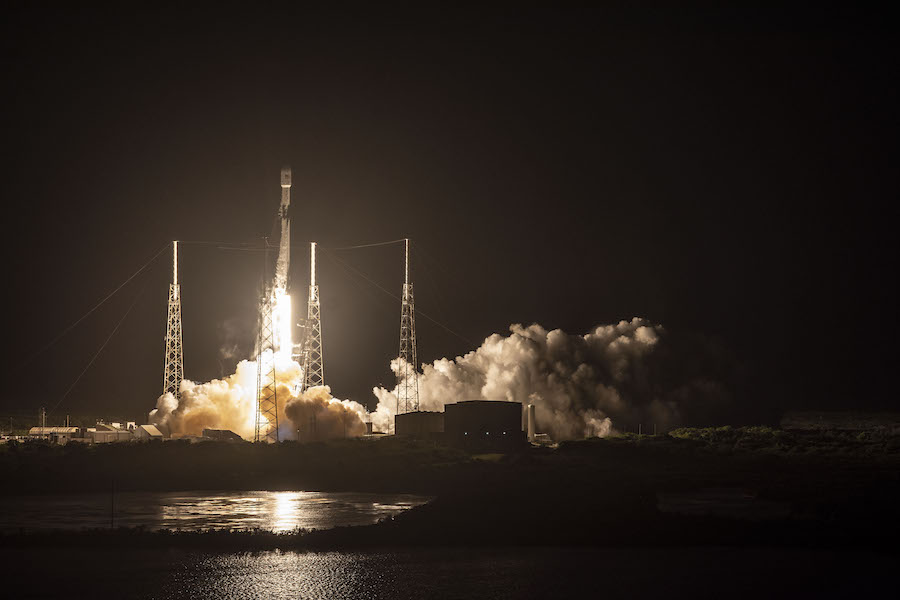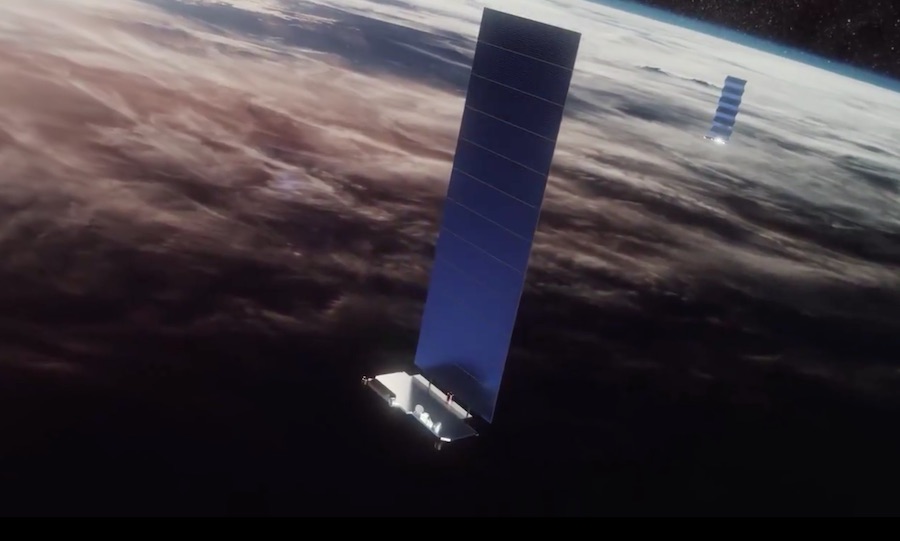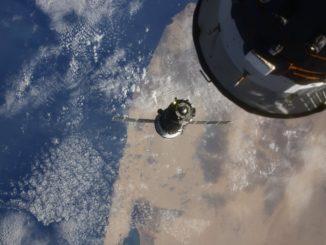
SpaceX successfully delivered the first 60 members of the company’s Starlink broadband satellite fleet to orbit Thursday night after a launch from Cape Canaveral.
The 60 small satellites, each with a flat-panel design and built by an in-house SpaceX team, will be joined by hundreds more Starlink craft over the next year to fill out the network’s preliminary constellation. Eventually, SpaceX says thousands of Starlink satellites may be launched to provide high-speed Internet services to consumers around the world.
Thursday night’s launch from Cape Canaveral was the first mission dedicated to the multibillion-dollar Starlink project.
“This is one of the hardest engineering projects I’ve ever seen done, and it’s been executed really well,” said Elon Musk, SpaceX’s founder and CEO, during a press briefing last week. “There is a lot of new technology here, and it’s possible that some of these satellites may not work, and in fact a small possibility that all the satellites will not work.
“We don’t want to count anything until it’s hatched, but these are, I think, a great design and we’ve done everything we can to maximize the probability of success,” he said.
A 229-foot-tall (70-meter) Falcon 9 rocket took off from Cape Canaveral’s Complex 40 launch pad at 10:30 p.m. EDT Thursday (0230 GMT Friday) to begin the journey into orbit atop 1.7 million pounds of thrust from nine Merlin main engines.
SpaceX tried to launch the mission twice last week, but unfavorable upper level winds forced the team to call off one launch attempt. Then SpaceX scrubbed another countdown the next day to allow time for engineers to update the software on the Starlink satellites, delaying the mission by a week.
Heading northeast from Florida’s Space Coast, the launcher’s first stage finished its job on the mission in two-and-a-half minutes, then separated and accomplished an on-target propulsive landing on SpaceX’s drone ship in the Atlantic Ocean.
The landing punctuated the booster’s third flight, following successful launches and recoveries last September and in January. SpaceX could refurbish and reuse the rocket again.
Recovery teams in the Atlantic also retrieved the two-part nose cone from the Falcon 9 rocket, which fell into the sea under parachutes. SpaceX has not yet re-flown a payload fairing.
The Falcon 9’s second stage engine shut down just shy the flight’s nine-minute point, and the rocket coasted across the Atlantic, over Europe and the Middle East, then reignited its Merlin engine for a brief maneuver to nudge the Starlink satellites into a targeted orbit 273 miles (440 kilometers) above Earth.
The rocket commanded release of the 60 Starlink satellites, each weighing around 500 pounds (227 kilograms), at 11:32 p.m. EDT (0332 GMT) as the launcher soared over a ground station in Tasmania. Live video transmitted through the tracking station showed the satellites flying free of the Falcon 9’s second stage, backdropped by the curvature of the Earth.
Stacked together inside the payload shroud of the Falcon 9 rocket, the 60 satellites weighed 15 tons (13,620 kilograms), making the cargo on Thursday night’s launch the heaviest ever lofted into orbit by SpaceX. The new mass record bested the weight of SpaceX’s fully-fueled Crew Dragon spacecraft, which launched March 2 on an unpiloted test flight to the International Space Station.
Musk described the unique Starlink separation scheme in a pre-launch press briefing.
“It will be a little bit different looking deployment than people are used to,” Musk told reporters last week. “It’s going to be a very slow deployment where we rotate the stage, and each of the satellites on the stack has a slightly different amount of rotational inertia.”
Live video from a camera on-board the upper stage showed the rocket begin a spin maneuver just before the deployment. The 60 flat-panel satellites separated in a clump, instead of one-at-a-time or in pairs, as spacecraft often do when releasing from the launch vehicle.
“So there’s not actually a spring-based or specific deployment mechanism per satellite,” Musk said. The satellites will kind of be deployed, it’s almost like spreading a deck of cards on a table. This will be kind of weird compared to normal satellite deployments.”
The Starlink satellites could be seen slowly dispersing soon after separating from the Falcon 9, before SpaceX ended its live webcast of the mission. The upper stage later conducted a deorbit burn to drop back into the atmosphere and burn up.
Musk tweeted after Thursday night’s launch that all 60 Starlink satellites were “online.” He said the satellites were expected to extend their power-generating solar panels and activate their ion thrusters within a few hours.
Each satellite carries a krypton ion propulsion system and Ku-band antennas to continue in-orbit demonstrations of SpaceX’s planned broadband network, which may eventually number up to 12,000 small relay stations in low Earth orbit.
Future Starlink satellites will carry Ka-band and V-band radio transmission hardware, along with laser inter-satellite links to allow signals to bounce between spacecraft in orbit, rather than going through a ground station.
Each Starlink spacecraft has a flat-panel design with four high-throughput phased array antennas and a single solar array, according to information released by SpaceX. The company built the satellites at a new facility in Redmond, Washington.
SpaceX says the Starlink satellites are the first to use krypton-fueled ion thrusters. The propulsion system ionizes the krypton gas and uses electricity to accelerate the atoms out the back of the engine to produce a low level of thrust.
Ion thrusters provide a more fuel-efficient form of propulsion than conventional liquid propellants, but most satellites that use ion propulsion consume xenon gas. Krypton is less expensive than xenon, but offers lower thrust efficiency, according to a 2011 paper presented by U.S. Air Force and satellite industry engineers.
The satellites also have computer smarts allowing the craft to autonomously avoid collisions with other objects in space.
Proposals by SpaceX and other would-be commercial broadband providers planning to launch thousands of new satellites into orbit have raised questions about traffic management. SpaceX originally intended to launch the first batch of Starlink satellites to a higher 741-mile-high (1,150-kilometer) orbit, but the company requested authority from the Federal Communications Commission last year to begin operating the network at a lower altitude.
The FCC approved the request last month.

SpaceX officials said the lower operating altitude for the first Starlink satellites will help assuage space debris concerns. If a Starlink relay station in the lower orbit fails, atmospheric drag will bring the satellite back to Earth within about five years.
“Additionally, 95 percent of all components of this design will quickly burn in Earth’s atmosphere at the end of each satellite’s life cycle — exceeding all current safety standards — with future iterative designs moving to complete disintegration,” SpaceX said in the press kit on the Starlink mission.
SpaceX launched two Starlink test satellites as piggyback payloads on a Falcon 9 launch last year, but the craft launched Thursday night are lighter and use a different design.
Using their krypton thrusters, the new Starlink satellites will climb into higher orbits 341 miles (550 kilometers) above Earth, at an inclination of 53 degrees to the equator.
Past initiatives to create an expansive communications satellite network in low Earth orbit, a regime a few hundred miles above Earth, have met technical and financial headwinds. Traditional communications satellites fly in higher geostationary orbits more than 22,000 miles (nearly 36,000 kilometers) above the equator, with a single spacecraft covering a wide geographic region.
In lower orbits, the Starlink satellites will bounce signals from user-to-user via an intricate web of radio connections through ground stations, and eventually through the inter-satellite laser cross-links.
“The goal of the Starlink system is to provide high bandwidth, low latency connectivity, ideally throughout the world provided we get regulatory approval, and this would provide connectivity to people that don’t have any connectivity today, or where it’s extremely expensive and unreliable as well as providing options for people who may have connectivity today in developed areas of the world but it’s very expensive,” Musk said. “This will provide a competitive option for them.”
Starlink is one of several companies working on constellations of small broadband satellites in low Earth orbit. Backed by a roster of international investors, including Japan’s SoftBank Group, OneWeb launched its first six satellites in February on a Soyuz rocket, with plans to send hundreds more into orbit over the next two years, and Amazon says it plans to build a network consisting of thousands of satellites for Internet service.
“There’s a lot of fundamental goodness about Starlink,” he said. “We just want to make sure the appropriate caveats are there. There’s a lot of technology, this is very hard, and quite frankly in the past, the success of low-Earth orbit communications constellations, I believe none have successfully gone into operation without going bankrupt.”
Spaceflight Now members can read a transcript of the May 15 press call with Elon Musk. Become a member today and support our coverage.
SpaceX has secured regulatory approval from the Federal Communications Commission for nearly 12,000 Starlink satellites broadcasting in Ku-band, Ka-band and V-band frequencies, with groups of spacecraft positioned at different altitudes and in various planes in low Earth orbit. But the early focus is on launching hundreds of the satellites to establish a network that covers most of the world’s population.
“It’s important to distinguish between initial operational capability, which is around the 400-satellite level, and then significant operational capability is around 800-satellite level, and thereafter, it’s about adding more and more satellites and more orbital planes of satellites as we get more usage of the system and we get bandwidth constrained,” Musk said. “One does not need anywhere near 10,000 satellites to be effective. … We’ll start selling service initial around the 400th satellite launch and then make sure our production and launch of satellites stays ahead of user demand.”
If there’s demand, SpaceX could scale up the network to reach the 12,000-satellite threshold.
After the first Starlink launch, SpaceX plans between two and six additional Starlink missions later this year to begin building out the first phase of the network in orbit 341 miles above Earth, according to Gwynne Shotwell, SpaceX’s president and chief operating officer.
SpaceX debuted a new Starlink website soon after Thursday night’s launch. According to the website, the Starlink system will provide broadband service over the latitudes of the northern United States and Canada after six additional launches. After 24 launches, the network should cover the populated world.
Musk said the user terminal consumers will use to connect with the Starlink network is a flat antenna — about the size of a small or medium pizza — that is relatively simple to set up. He did not say how much the user terminal will cost, or disclose the expected price of a subscription to Starlink’s broadband service.
In addition to consumer-scale broadband, the Starlink network could help large telecom operators in rural areas. Airplanes and ships are also prime markets for Starlink.
“We think this could be really helpful to telcos (telecom operators) by providing connectivity that they need for the most difficult to serve customers, as well as providing data backhaul services so that a telco could put down a 5G cell tower somewhere instead of digging a fiber trench over potentially hundreds of miles,” Musk said. “That 5G cell tower could do data backhaul through our satellite system.”
Musk said SpaceX has enough money to get the privately-funded Starlink system operational. A filing with the Securities and Exchange Commission last month showed SpaceX had raised $44 million in a $400 million fundraising round, and a filing in January showed SpaceX had raised $273 million of a planned $500 million in an earlier round.
But Musk told reporters last week that SpaceX’s funding rounds have been “oversubscribed,” and suggested the information contained in the regulatory filings was “out-of-date.”
“This is obviously a multibillion-dollar endeavor,” Musk said. “So we’ve got the cash flow that we generate from our normal launch operations, launching commercial satellites and launching Dragon to the space station, that kind of thing, as well as capital that we have raised. At this point, it looks like we have sufficient capital to get to an operational level, but of course, if things go wrong and there are unexpected issues, we will need to raise more capital in that situation.”
Tim Farrar, a satellite and telecommunications industry consultant, said the first launches for the SpaceX and OneWeb broadband networks puts pressure on other players.
“We’re going to be involved in a race between SpaceX and OneWeb to launch as many satellites as possible,” Farrar said in an interview with Spaceflight Now before the Starlink launch. “It sort of limits the opportunities for other constellations like Telesat to find partners and raise money, unless they’re going find some deal with Jeff Bezos and Amazon.
“OneWeb was talking … about launching as many 100 satellites by the end of this year or early next year. SpaceX is talking about having multiple additional launches over the next six to 12 months,” said Farrar, president of TMF Associates, a consulting firm in Menlo Park, California. “At that point you do have a question … Is there room for another player that’s going to take a couple of years before they can even launch any more satellites?”
For Musk, the Starlink system is not only a business opportunity. It could also offer a potential revenue stream for SpaceX to pay for costly rocket development projects, such as the company’s Starship and Super Heavy vehicles, which Musk envisions as a reusable multi-purpose vehicle for huge satellite launches and interplanetary voyages with cargo and people.
“We see this as a way for SpaceX to generate revenue that can be used to develop more and more advanced rockets and spaceships, and we think this is a key stepping stone on the way toward establishing a self-sustaining on Mars and a base on the moon,” Musk said. “We believe we can use the revenue from Starlink to fund Starship.”
Email the author.
Follow Stephen Clark on Twitter: @StephenClark1.



